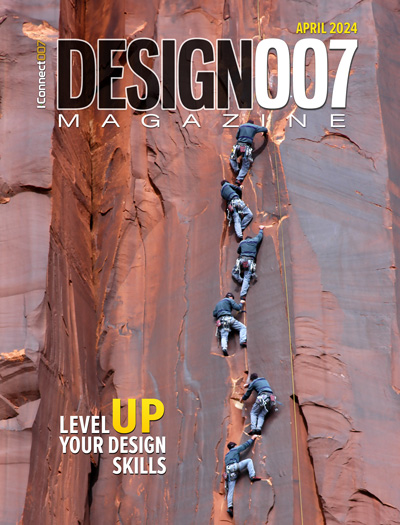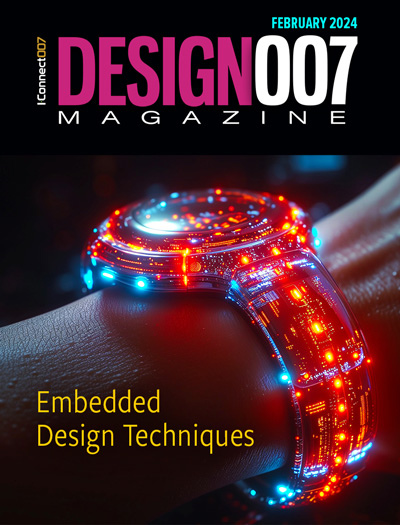-

- News
- Books
Featured Books
- design007 Magazine
Latest Issues
Current Issue
Level Up Your Design Skills
This month, our contributors discuss the PCB design classes available at IPC APEX EXPO 2024. As they explain, these courses cover everything from the basics of design through avoiding over-constraining high-speed boards, and so much more!

Opportunities and Challenges
In this issue, our expert contributors discuss the many opportunities and challenges in the PCB design community, and what can be done to grow the numbers of PCB designers—and design instructors.

Embedded Design Techniques
Our expert contributors provide the knowledge this month that designers need to be aware of to make intelligent, educated decisions about embedded design. Many design and manufacturing hurdles can trip up designers who are new to this technology.
- Articles
- Columns
Search Console
- Links
- Events
||| MENU - design007 Magazine
Lee Ritchey On the Future of PCB Design
December 11, 2017 | Barry Matties, Publisher, I-Connect007Estimated reading time: 17 minutes
I spoke with long-time PCB design instructor and Right the First Time author Lee Ritchey during the recent AltiumLive event in Germany. Lee and I discussed everything from the advice he offers to young PCB designers to his thoughts on where the industry is going and what’s missing from today’s electrical engineering curriculum.
Barry Matties: Lee, you’re the keynote speaker here at the AltiumLive event in Munich, Germany. It’s also your first keynote. I'm surprised.
Lee Ritchey: I've been thinking about what I presented in this keynote for a long time. Where are we? Where are we going? Dozens of people have asked me those questions, and I've finally pulled it all together in one place. And a fab shop does not want to hear most of what I mentioned. Neither does a laminate supplier, because we're making their market smaller with integrated circuits. Every year we make it smaller, and probably the best example I can think of is the Xbox 360, which is a four-layer board about 10 inches on a side and it is a super computer. Literally a super computer, so that a kid can play a game and I can't even guess at how many MIPS it has; I don't think that you can buy a stand-alone computer that big, and we call it a game. Not unlike your phone.
Matties: You had a chart in your presentation showing the phone in the center and all the items that it's replaced over time around it. It's a video recorder, it's a radio, and it’s so much more than a phone.
Ritchey: It's four radios. You've got Bluetooth, you've got wireless, you've got GPS, and, oh by the way, you also have a phone. It's all there.
Matties: It's interesting…you also said when you looked ahead 20 years ago that you would have never imagined where we are today. I find that kind of surprising.
Ritchey: Let's go back a little bit. No one expected workstations to be what they were. That wasn't what it started out to be. You may not know that, but we had timeshare, if you remember? And all Andy Bechtolsheim was doing was putting a microprocessor in his dumb terminal so that some of the data didn't have to go to mainframe. Well, it wound up eliminating the mainframe. The PC is the same way. You may not know this, but IBM did not set out to make a PC. I was doing IC testing at the time and when we made a tester for an IC, we had a fixed test pattern. When the chips are simple, you can hard code the test pattern, but when they get more complex that's not true. So IBM came out to California to find a processor that could be a programmable tester for their IC factory. No PC intended at all, and once it was there, their club had been putting word processors and that sort of thing on other products and somebody decided, "Well, heck, we got this microprocessor here. Why don't we put a spreadsheet on it?" The rest is history. It was not intended to be a personal computer at all and you can point to all kinds of products.
Matties: They didn't really think there was a large market for the personal computer.
Ritchey: Not at all, not at all.
Matties: I think there is a famous quote that said they saw there was a market of maybe one.
Ritchey: That was the founder of DEC computers. I have a book called “Accidental Empires” [by Robert X. Cringely] that describes this. For example, Bill Gates didn't start out to make Microsoft. He was selling code to IBM to run the testers, and almost everything that made it to market started the same way. The originator did not have that in mind at all, and that's why I can't forecast the future, because nobody has done that right.
Matties: You also mentioned that the numbers of designers, shops and jobs have dropped because of the density of a board and consolidating into such a small package with so much functionality.
Ritchey: Well, it's the integrated circuit. If you tear your phone apart, you'll discover there's one chip in there. It has those four radios and everything else.
Matties: All in that one chip with how many transistors?
Ritchey: I would guess that there's probably eight or 10 billion.
Matties: In my pocket! Most people don’t think in those terms. What you were saying is there was less of a need because we're designing fewer boards, but on the other hand because of the expanded functionality, there’s a lot of new opportunity for products to enter the marketplace. And it seems like everything has electronics now that years ago just wasn't even practical. Down to tennis shoes.
Ritchey: That's true. There are new products that somebody thought of that you and I didn't that catch on to. I guess the place where I'm sort of dumbfounded is cars. In my car, 50% of the cost is electronics. It has about 40 microprocessors in it, but it's just a car. It has a network in it, and you can point to a lot of things like that, that somebody figured out. I was just talking to a lady a little while ago who said that the high-end cars have 10 or 12 radars on top of everything else, like collision-avoidance radars. My car beeps at me every time I get too close at something. I like that, by the way. I don't dent as many fenders.
Matties: To my point though, it just seems like there's a greater demand for more and more boards every time I look. Because when you look at autonomous cars, and as you're mentioning the number of electronics on board, it just seems to me that there is a greater demand for more boards than we've ever had.
Ritchey: I'm not sure that's true. We may be getting back to where we were when we took 10 boards to make a system, but the way I see it is all the boards are smaller and simpler. I don't need 24 layers anymore.
Matties: Right, so maybe we're not building as many panels, but they're so small, we can get 12x or so on a panel today.
Ritchey: Yes, that's right. And of course that's bad news for the laminate manufacturers, right? On top of that, especially all these differential lengths are equipped with all manner of compensation so that you can make something work at a very high data rate on a fairly poor laminate or cheap laminate. Right now, the board I was talking about where we had 28 gigabit links, that's not even on a low-loss laminate. It's the stuff you call FR-4. Because the silicon got so good, now we're going to push that some more and find out what that brings, but as I said, none of us guessed right when we tried to guess where the limits are or what the next product is going to be. If I could, I wouldn't be here. I'd have so much money from investing in my startups that I wouldn't work anymore. No, I would work, because I don't like sitting around, but I've missed almost every one of those ideas that exploded. I've missed it because I didn't believe it would be a product. I was offered stock in Sun. “Workstations aren't going to go anywhere.” I was offered founders stock in Intel. I said, "CMOS are not going to go anywhere." I hate to tell you how many of those I did.
Page 1 of 3
Suggested Items
Insulectro’s 'Storekeepers' Extend Their Welcome to Technology Village at IPC APEX EXPO
04/03/2024 | InsulectroInsulectro, the largest distributor of materials for use in the manufacture of PCBs and printed electronics, welcomes attendees to its TECHNOLOGY VILLAGE during this year’s IPC APEX EXPO at the Anaheim Convention Center, April 9-11, 2024.
ENNOVI Introduces a New Flexible Circuit Production Process for Low Voltage Connectivity in EV Battery Cell Contacting Systems
04/03/2024 | PRNewswireENNOVI, a mobility electrification solutions partner, introduces a more advanced and sustainable way of producing flexible circuits for low voltage signals in electric vehicle (EV) battery cell contacting systems.
Heavy Copper PCBs: Bridging the Gap Between Design and Fabrication, Part 1
04/01/2024 | Yash Sutariya, Saturn Electronics ServicesThey call me Sparky. This is due to my talent for getting shocked by a variety of voltages and because I cannot seem to keep my hands out of power control cabinets. While I do not have the time to throw the knife switch to the off position, that doesn’t stop me from sticking screwdrivers into the fuse boxes. In all honesty, I’m lucky to be alive. Fortunately, I also have a talent for building high-voltage heavy copper circuit boards. Since this is where I spend most of my time, I can guide you through some potential design for manufacturability (DFM) hazards you may encounter with heavy copper design.
Trouble in Your Tank: Supporting IC Substrates and Advanced Packaging, Part 5
03/19/2024 | Michael Carano -- Column: Trouble in Your TankDirect metallization systems based on conductive graphite or carbon dispersion are quickly gaining acceptance worldwide. Indeed, the environmental and productivity gains one can achieve with these processes are outstanding. In today’s highly competitive and litigious environment, direct metallization reduces costs associated with compliance, waste treatment, and legal issues related to chemical exposure. What makes these processes leaders in the direct metallization space?
AT&S Shines with Purest Copper on World Recycling Day
03/18/2024 | AT&SThe Styrian microelectronics specialist AT&S is taking World Recycling Day as an opportunity to review the progress that has been made in recent months at its sites around the world in terms of the efficient use of resources:


